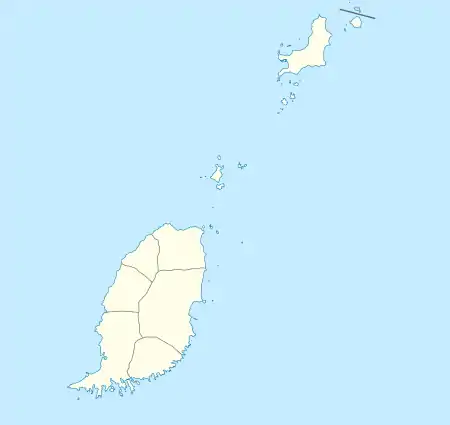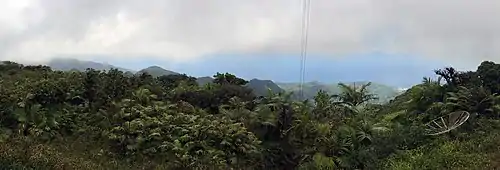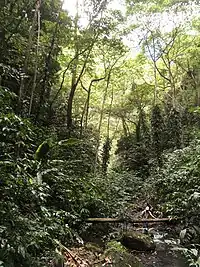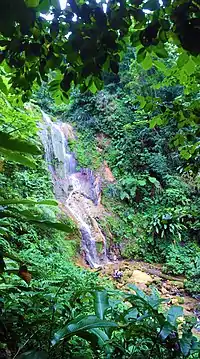| Mount St. Catherine Forest Reserve | |
|---|---|
 Reserve boundaries and Land-Use Land-Cover Classification | |
 | |
| Nearest town | Victoria |
| Coordinates | 12°09′44″N 61°40′30″W / 12.162281°N 61.675035°W |
| Area | 2,308 acres (9.34 km2) |
| Max. elevation | 840 m |
The Mount St. Catherine Forest Reserve is the second largest declared terrestrial protected area in Grenada after the Grand Etang and Annandale Forest Reserves.[1] Covering 934 ha (2,310 acres) within a 31.7 km (19.7 mi) boundary perimeter, its headwaters drain across seven of the largest watersheds on the island and supply important catchment basins for water distribution to Grenadians and agrarian landscapes downstream. The forest reserve encompasses the principal peak of the Mount Saint Catherine massif—the highest point on the island 840 m (2,760 ft), as well as other lushly forested ridges and lesser peaks (e.g. Mount Hope), the highest waterfall in the country (Tufton Hall Waterfalls), the majority of the island's known hot springs, including the hottest geothermal spring (Hapsack Springs) and its most accessible geothermal bathing pool (Clabony Sulphur Springs).[2]
Physical environment and ecology
The Mt. St. Catherine massif is an extensively weathered volcano that is considered dormant because it has likely not erupted since the last ice age.[3] It is considered to be the only live volcano among the five volcanic centers in Grenada on account of its relatively well-preserved morphology and the presence of hot springs and fumaroles on its flanks.[4] The forest reserve area is typical of tropical montane cloud forests, which develop in areas where clouds impinge almost continuously on tropical mountain vegetation and differ from lowland rainforests in structure (low stature, small and tough leaves, low diversity) and function (low productivity and low nutrient-cycling rates). They are considered highly endangered ecosystems on account that these forest formations are rare, fragile, and are probably disappearing faster than any other forest ecosystem in the neotropics today.[5]



The Mt. St. Catherine Forest Reserve is further representative of lowland rainforest and lower montane cloud forest,[6] with its highland vegetation of dense tree growth comprising forest formations of Sierra palm, transitional and tall cloud forest, and Elfin/Sierra palm cloud forest,[7] laden with ferns, mosses and other epiphytes and typical stunted woodland growth at higher exposed elevations. In the sheltered lower elevations, the forest is relatively mature, comparable to other rainforests of the island (e.g. Grand Etang and Annandale). Secondary forest growth from past cut-over rainforest is apparent surrounding lower supporting ridges and around the periphery of the reserve, with mixed-woody agriculture (particularly, agroforestry plantations of nutmeg and cacao) crossing over the forest reserve boundaries mainly on the sides of the reserve by Victoriaville and Mt. Horne.[2]

The cloud-forest ecosystem in the Mt. St. Catherine Forest Reserve is a valuable water resource for Grenada. Significant amounts of rainfall and cloud-mist condensate are collected within its highland forests and dispersed downslope throughout the year. It is critically important to the overall watershed regimes on the island as the main rivers and tributaries with perennial flow in Grenada are relatively small, rainfall is highly seasonal and locally limited, and only about 10% of drinking water for the population is generated through groundwater.[8] The Mt. St. Catherine Forest Reserve, along with other montane areas of the island, provides a range of critical watershed services, including hydrological regulation, flood control, groundwater recharge, water quality enhancement, and soil conservation.[9][10]
Hiking and trails
(Summit trails downloadable from Wikiloc)
Hiking in the Mt. St. Catherine Forest Reserve is diverse, including three steep, rugged routes to the top of the cloud forest and the Mount Saint Catherine summit, recreational strolling areas in scenic agroforestry settings, and challenging river trekking to geothermal features and waterfalls. The trail system leading to the forest reserve and continuing to an extent within limits of the reserve are based on old estate roads and tracks established to service crop production in the past and are generally well maintained (hiking level is easy). These may be considered more of a walk on gentle hills along a hard packed trail over a short distance (1 h or less). The main trails starting at the foot of the mountain towards the summit vary in their levels of difficulty (moderate to difficult, 3+ hours). The moderate sections of these main trails cover steep terrain with much elevation gain, at times over rocky and muddy parts, but are generally well worn and free of encumbering vegetation. The difficult sections of these main trails may be technically challenging (e.g. requiring the use of hands) with considerable elevation gain, often over steep rocky and muddy terrain, and would not be completed unless one is in good physical condition. Secondary trails exist off these main trails (only used in hunting) and requires bushwhacking and route-finding skills to navigate.
References
- ↑ Hubber, R. & Vincent, G (1988). "Plan and Policy for a System of National Parks and Protected Areas" (PDF).
- 1 2 Aucoin, S. (2018). "Mount St. Catherine Forest Reserve Environmental Baseline Assessment".
- ↑ "Grenada, country environmental profile" (PDF).
- ↑ "Global Volcanism Program - St. Catherine". National Museum of Natural History, Smithsonian Institution. 12 August 2018.
- ↑ LaBastille, A. & Pool, D. J. (1978). "On the Need for a System of Cloud-forest Parks in Middle America and the Caribbean". Environmental Conservation. 5 (3): 183–190. doi:10.1017/S0376892900005890.
- ↑ Grubb, P. J. (1971). "Interpretation of the 'Massenerhebung' effect on tropical mountains". Nature. 229 (5279): 44–45. doi:10.1038/229044a0. PMID 16059069. S2CID 4245810.
- ↑ Helmer, E. H.; Kennaway, T. A.; Pedreros, D. H.; Clark, M. L.; Marcano-Vega, H.; Tieszen, L. L.; Schill, S. R. & Carrington, C. M. S. (2008). "Land cover and forest formation distributions for St. Kitts, Nevis, St. Eustatius, Grenada and Barbados from decision tree classification of cloud-cleared satellite imagery". Caribbean Journal of Science. 44 (2): 175–198. doi:10.18475/cjos.v44i2.a6. S2CID 88294941.
- ↑ "Project for a climate resilient water sector in Grenada" (PDF).
- ↑ Sharachchandra, L. (1978). "Watershed services of tropical forests: from hydrology to economic valuation to integrated analysis". Current Opinion in Environmental Sustainability. 1 (2): 148–155. doi:10.1016/j.cosust.2009.10.007.
- ↑ Bonell, M.; Bruijnzeel, L. A. (2004). Forests, water and people in the humid tropics: Past, present and future hydrological research for integrated land and water management. UK: Cambridge University Press. p. 925. ISBN 0521829534.